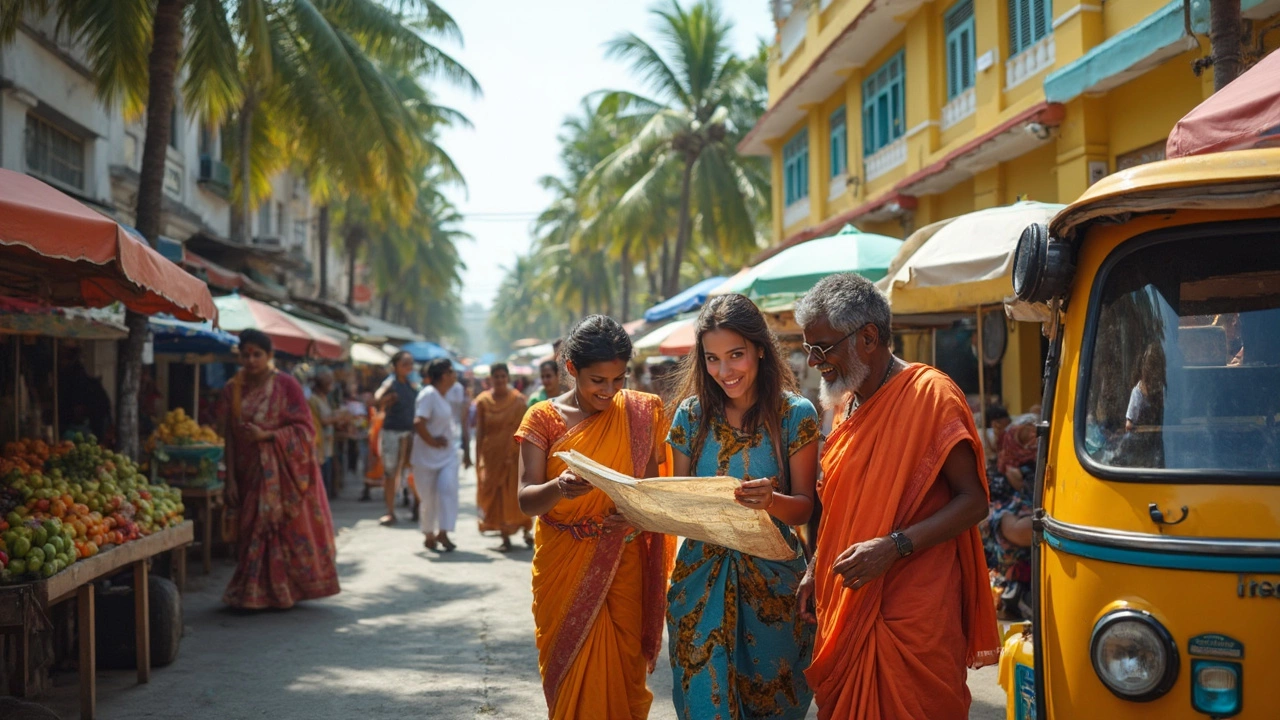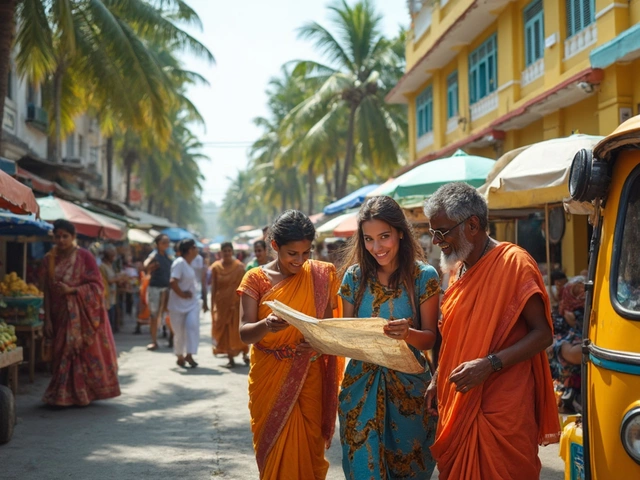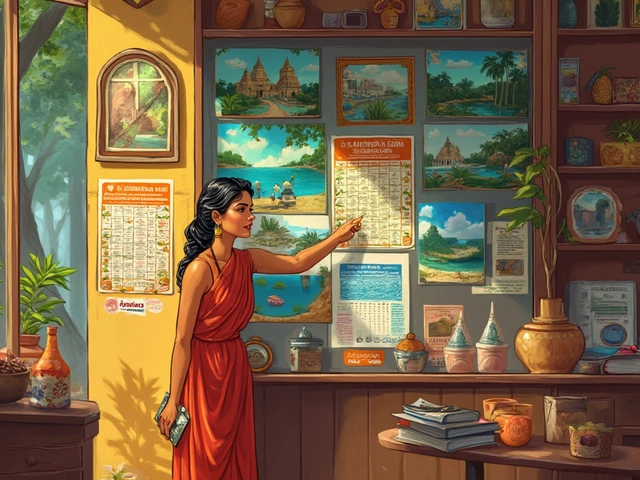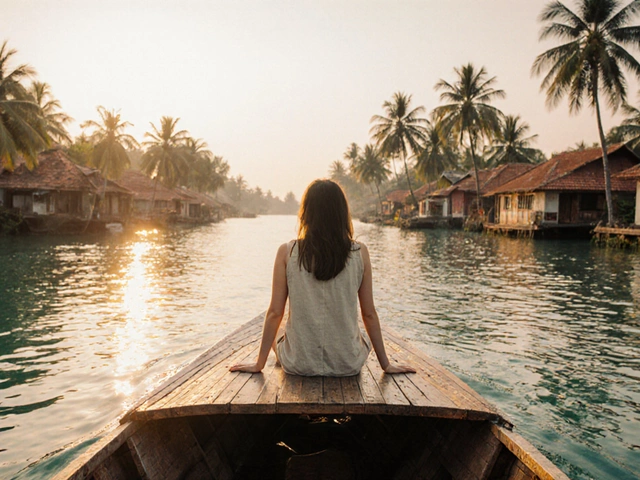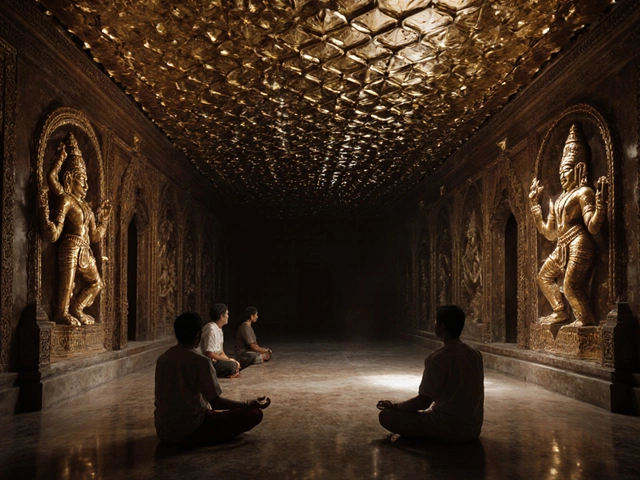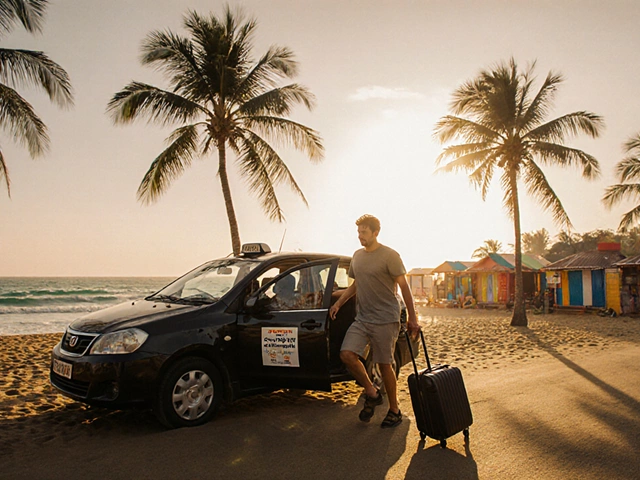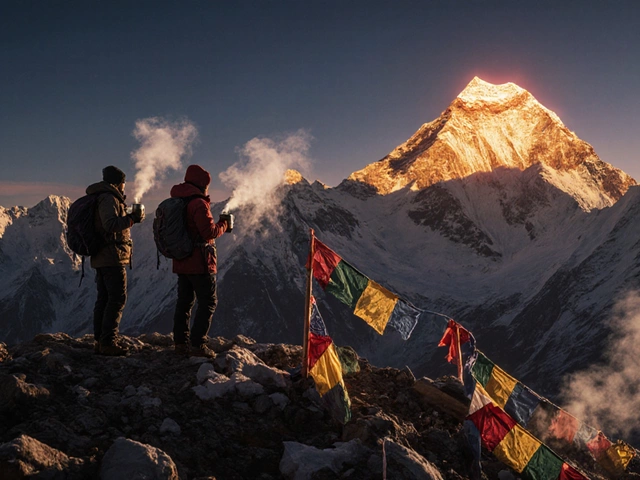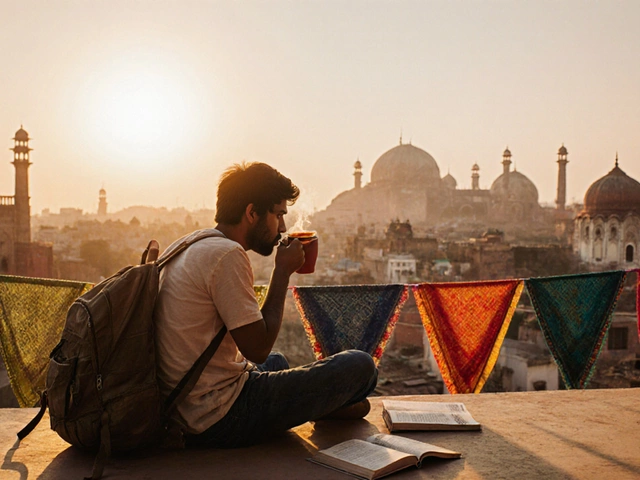So, you want to visit India but you’re not sure where to start. Here’s the thing—jumping headfirst into Delhi’s chaos or Varanasi’s intensity can be too much for your first trip. South India offers a different vibe: it’s more laid-back, friendlier to newcomers, and usually easier on your comfort zone. You get stunning beaches, hill stations, ancient temples, spicy but not stomach-destroying food, and plenty of safe places to start exploring. Plus, major cities like Kochi, Bengaluru, and Chennai have all the basics you’ll need—think good hospitals, clean hotels, and English spoken widely.
If you’ve ever wondered about real India without the stressful crowds, South India is where you’ll find a mix of everything. You can start in Kerala’s backwaters, drift over to Tamil Nadu’s temples, and end up sipping filter coffee in a cool café in Bengaluru. Each place is different, but travel here feels more doable for beginners. And don’t worry! You’ll still feel that unmistakable energy and color that makes India famous—just without getting totally overwhelmed on your first day. Now, let's get practical about how to make your first trip amazing.
- Why South India Wins for First-Timers
- Top Destinations to Put on Your Itinerary
- Food, Drinks, and Stomach Peace
- Getting Around: Trains, Planes, and Apps
- Culture Shocks and How to Dodge Them
- Best Times to Go and What to Pack
Why South India Wins for First-Timers
Let’s be real—India is not a small country, and your first visit can feel like a lot. But South India is where the sense of "overwhelm" drops and the welcome hits differently. It’s cleaner, the pace is more chill, scams and touts are less pushy, and people are often genuinely curious and happy to help, especially when you stick to well-known towns and cities.
One big win is the weather. South India has a tropical climate with milder winters. If you show up between November and February, you’ll get balmy days that are perfect for sightseeing, unlike the boiling summers or smoggy winters up north.
You might be wondering, “Will I be safe?” Numbers back this up: a 2023 report by the National Crime Records Bureau ranked states like Kerala, Karnataka, and Tamil Nadu among the safer spots for tourists, with far fewer incidents reported compared to the north. Also, English is widely spoken, making it easier to get around, read signs, and order food without doing elaborate hand gestures at every meal.
- First time India trips come with pre-trip anxiety. South India takes away a lot of those nerves thanks to friendly folks, clean transport, and better tourist infrastructure.
- Hygiene shock is real, but South India’s cities (think Bengaluru or Kochi) have loads of clean cafés, Western toilets, and proper pharmacies for tummy troubles or mosquito bites.
- Food is spicy but often served with coconut milk and rice, which is much easier on sensitive stomachs than the heavier gravies from the north. You’ll actually look forward to eating out.
- Iconic sights? You’re covered. From Kerala’s laid-back backwaters and tea hills to the giant temples of Madurai and Mahabalipuram, you’ll see why people fall for this side of India.
Here’s a quick look at how South compares with North for first-timers:
| South India | North India | |
|---|---|---|
| Language | English widely spoken | Varies, less common outside tourist spots |
| Cleanliness | Generally cleaner cities | Major cities often crowded and dusty |
| Food | Lighter, coconut-based (easier for sensitive stomachs) | Heavier with more spices and oil |
| Safety for Tourists | Higher ranking in tourist safety | More reported scams and petty theft |
| Pace | More relaxed, less frantic | Fast-paced, especially in Delhi and Agra |
This doesn’t mean North India isn’t great—it’s just more of a wild ride. If you want an easy, friendly, first taste of real India, the south is the sweet spot. There’s no better way to break in your travel legs here.
Top Destinations to Put on Your Itinerary
South India is packed with places you just can’t skip, whether you’re going for landscapes, history, or food. It’s really about matching what you want—relaxing, sightseeing, or a bit of both. Here’s where most first-timers get the best mix and why these should be at the top of your list:
- Kochi (Cochin): This port city in Kerala is like a soft landing spot. You get fort areas, old churches, and these Chinese fishing nets you’ll want to photograph. Artsy cafes make it easy to recover from jet lag. You can take a cheap ferry or auto-rickshaw to explore all day.
- Alleppey (Alappuzha): Just two hours from Kochi is Kerala's famous backwaters. Renting a houseboat (even just for an afternoon) is a chill way to watch village life on the water. Budget boats are easy to find, especially outside peak winter.
- Madurai: Tamil Nadu’s famous city is all about the Meenakshi Temple—a colorful and massive complex that runs on rituals and energy round the clock. Late-night food streets are legendary here too.
- Mysuru (Mysore): Karnataka’s palace city is safe, clean, and walkable. Check out the royal Mysore Palace lit up every Sunday night and try the local sweet called Mysore Pak. This place is manageable even if you’re not an early bird traveler.
- Hampi: This UNESCO site is surreal—think giant boulders, old temple ruins, and coconut groves. Easy guesthouses and scooter rentals make it great for budget travelers. Skip the hottest months (March to May), though; it gets brutal.
- Puducherry (Pondicherry): Once a French outpost, it’s still got bakeries, pastel-colored houses, and a calm seafront. Most people rent a cycle and just coast around. Perfect for a little break from big cities.
Not sure how long to spend in each? Here’s a quick guide (you can tweak this based on your own pace):
| Destination | Recommended Days | Must-See |
|---|---|---|
| Kochi | 2–3 | Fort Kochi, Jewish Synagogue, Local Markets |
| Alleppey | 1–2 | Backwater Houseboat, Alleppey Beach |
| Madurai | 2 | Meenakshi Temple, Food Streets |
| Mysuru | 2–3 | Mysore Palace, Chamundi Hill |
| Hampi | 2–3 | Vijaya Vittala Temple, Sunset Points |
| Puducherry | 2 | French Quarter, Promenade Beach |
Here’s a tip: Use trains or buses to travel between these cities. It’s affordable, and you get to see a lot more of the countryside. And if you’re worried about where to start, most flights into South India go through Kochi, Bengaluru, or Chennai, so plan your route around whichever city you arrive in.
For your first time India experience, these south Indian spots keep things doable, interesting, and less overwhelming. You’ll get temples, beaches, nature, and loads of local flavor. And you don’t have to rush—you’ll want time to just soak it in.
Food, Drinks, and Stomach Peace
Eating in South India is a treat, but newbies always worry about getting sick. Good news: South Indian food relies on steaming, fermenting, and lots of spices, which actually helps kill off bacteria. Still, you can’t just chow down anywhere and expect your stomach to behave.
The classic choices—dosa, idli, and sambar—are safe bets for beginners. These are made fresh, usually right in front of you. Idlis are steamed rice cakes, and dosas are thin, crispy pancakes. Both are easy on the stomach and not overwhelmingly spicy. If you’re worried about raw veggies or street snacks, just stick to the cooked stuff at busy places where locals eat. Local joints turn out food fast so it hasn’t been sitting long.
- Only drink bottled water. Double-check that the seal isn’t broken.
- Avoid ice cubes in drinks—some places make ice with tap water.
- Peel your own fruit as a simple trick to dodge odd stomach bugs.
- Love chai? Go for it. Boiling water makes it safe. The same goes for filter coffee.
- If you want to try roadside snacks, pick stalls that have a crowd—locals know what’s good and safe.
If you do run into trouble, pharmacies in every town sell safe, over-the-counter medicine like ORS sachets (for rehydration) and probiotics. Most people bounce back in a day or two if they keep hydrated and rest up.
| Common Food | Safe to Eat? | Pro Tips |
|---|---|---|
| Idli & Dosa | Yes | Order freshly made. Great for breakfast. |
| Street Food (Pani Puri, Samosa) | If hot & crowded | Eat where you see locals queue up. |
| Raw Salad | No | Skip unless in a high-end restaurant. |
| Bottled Drinks | Yes | Check the seal. |
| Local Fruit | Yes (if peeled yourself) | Banana, papaya—easy, cheap, and safe. |
If you stick to these commonsense habits, you’ll probably enjoy every meal. The flavors in South India are unique—spices like curry leaves and mustard seeds pop up in almost everything. Vegetarian food is everywhere and honestly, it’s so tasty you might not even think about meat. Enjoy the adventure, but listen to your body and remember: a little caution goes a long way for first time India trips.
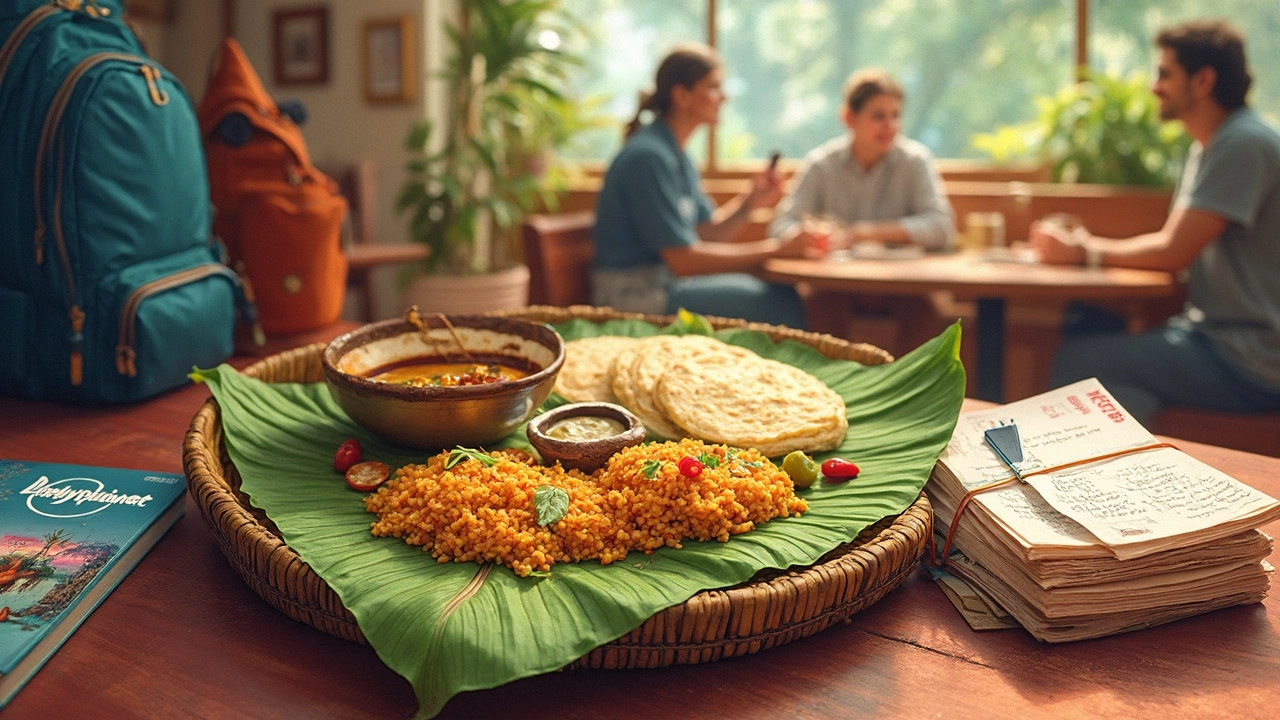
Getting Around: Trains, Planes, and Apps
South India isn’t tiny, and figuring out how to move between places is key. Good news: most of the region is well connected by trains, planes, and reliable taxi apps, making travel here less of a headache—especially for your first time India trip. Let’s break down your options.
Trains are the soul of Indian travel. The Indian Railways network is massive, and Southern states are no exception. For first-timers, go for higher classes like 2AC or 3AC—these are air-conditioned and give you reserved seats or berths, which helps you avoid the crowds and heat. Booking is easiest on IRCTC (the official website), or even better, apps like Cleartrip or MakeMyTrip, both of which have friendlier user interfaces. Do book in advance, especially during festival seasons or around local holidays.
For bigger jumps—say, from Kochi to Chennai or Bengaluru to Thiruvananthapuram—domestic flights are quick and surprisingly affordable if you book ahead. IndiGo, Air Asia, and Vistara are the popular budget airlines down south. Expect basic service, limited food, but almost always on-time departures. Airports in South India generally function smoothly, security is straightforward, and English is spoken at all counters. Most cities have airports within an hour’s taxi ride from the center.
Buses are cheap and useful, especially for short trips—for example, Munnar to Kochi or Pondicherry to Chennai. Opt for state-run “Volvo” (AC) buses or private luxury buses when possible. Just remember, sometimes schedules are more like loose guidelines than strict timetables, so double check online and with locals.
For local travel, skip the haggling and use taxi apps. Uber runs in most big cities, but Ola (India’s version of Uber) covers even smaller towns and you can pay cash. Auto-rickshaws usually have meters, but drivers might “forget” to use them. Don’t be shy about insisting on the meter or checking the usual fare online first.
- IRCTC: Official app/website for all train bookings. Needs an account, so set this up before you travel.
- Cleartrip & MakeMyTrip: The most user-friendly train and flight booking apps for foreigners. Integrated payment gateways work well for international cards.
- Ola & Uber: Lifesavers for city rides. Ola also has outstation cabs perfect for day trips.
- RedBus: Top app for booking intercity buses. Double-check operator ratings before booking.
- Google Maps: Actually pretty reliable for transit and walking navigation in South Indian cities.
| Transport | Best for | Pros | Cons |
|---|---|---|---|
| Train | Long, scenic journeys | Budget-friendly, authentic, AC classes comfy | Can be slow, tricky to book last minute |
| Flight | City hops & longer distances | Fast, efficient, competitive pricing | Airports could be far from city center |
| Bus | Smaller towns, cheap trips | Flexible, frequent, daytime views | Can be bumpy, sometimes late |
| Taxi/Auto apps | City trips, airport transfers | No haggling, AC options, safe | Surge pricing, sometimes slow arrival |
If you’re unsure when to book, here’s a simple rule: Book trains and flights at least two weeks in advance, especially in December–January (peak season). Download all the key apps before you land, and keep some small cash handy—card payments can glitch in remote spots. South Indian cities are easier to navigate than northern ones, but having your hotel’s address written down can help, especially after dark. Don't stress—once you get the hang of this mix of trains, planes, and cabs, you’ll move around South India like a local.
Culture Shocks and How to Dodge Them
No matter how much you prep, landing in South India can flip your expectations. It's usually way cleaner and calmer than North India, but some things will still catch you off guard. Here’s what most first-timers struggle with, and how to sidestep the awkwardness.
- Personal space is less of a thing: You might notice people stand close in lines and crowds. It’s not rude—it's just how things roll here. If you need space, just step back a bit or walk away, no one will chase you.
- Staring happens, especially if you look foreign: Folks might stare a little, sometimes a lot. It’s rarely about being rude or creepy. Just meeting your gaze and smiling back almost always breaks the tension.
- Eat with your hands: This can freak out neat-freaks, but eating rice and curry with your right hand is the norm. Don’t stress if you’re not perfect. Wash up at the sinks in restaurants before and after (never use your left hand for eating, by the way).
- Bargaining at markets: Malls have fixed prices, but in street markets, vendors expect a bit of back-and-forth. Offer half their first price and settle somewhere in the middle. Don’t feel guilty, everyone does it.
- Dress codes, especially at temples: South India is relaxed but temples have rules—men might have to take off shirts, women should cover knees and shoulders. Carrying a light scarf or shawl saves the day.
- Toilets are different: Expect squat toilets and sometimes bucket showers at basic places. Always carry your own toilet paper or tissues.
Most of all, don’t get defensive if people ask personal questions—stuff like where you’re from, are you married, or your job. It’s just curiosity, not an interrogation. You’ll probably have a few laughs about it later.
Keep an open mind, laugh off the unexpected, and remember you’re not the first person to be surprised. This is all part of the first time India experience—and you’ll get better at rolling with it every day.
Best Times to Go and What to Pack
Timing really changes your whole experience in South India. Most people find November to March the sweet spot. The heat turns down, monsoon rains are gone, and you get those cooler, dry days that are perfect for exploring. Kerala, Karnataka, Tamil Nadu, and Andhra Pradesh all feel welcoming this time—backwaters are calm, hill stations are fresh, and beaches are way more inviting. If your schedule is tight, late October or early April can still work, but expect a bit more sweat and crowds in big places like Kochi or Chennai during school holidays.
Skip South India from June to September unless you love nonstop rain and the challenge of soggy sightseeing—some areas do get flash floods. And May brings hot, sometimes sticky weather that can drain your energy, especially if you’re not used to tropical climates.
Let’s talk about packing. You’ll want to dress for heat and humidity, but keep in mind that modest clothing is the rule for temples and smaller towns. Here’s what works best for a first time India adventure:
- Loose, breathable tops (cotton or linen is your friend)
- Lightweight pants and long skirts over shorts—they’re comfy plus you blend in better outside touristy areas
- A scarf or shawl for temples and sudden chills on air-conditioned trains
- Sandals or slip-on shoes—most temples and homes ask you to go barefoot
- Light rain jacket if you even sniff monsoon season
- Small medical kit (think hand sanitizer, basic meds, mosquito spray—mosquitoes love the south, especially after dark)
- Spare phone charger and a universal adapter, since plug types can vary wildly from hotel to hotel
Also, pack sunscreen, sunglasses, and your favorite hat. South India’s sun is no joke, especially in the afternoons. Last tip: bring a reusable water bottle you can refill at your hotel—don’t risk drinking water straight from the tap, ever. Simple, practical, and you’ll be ready for whatever comes your way.
